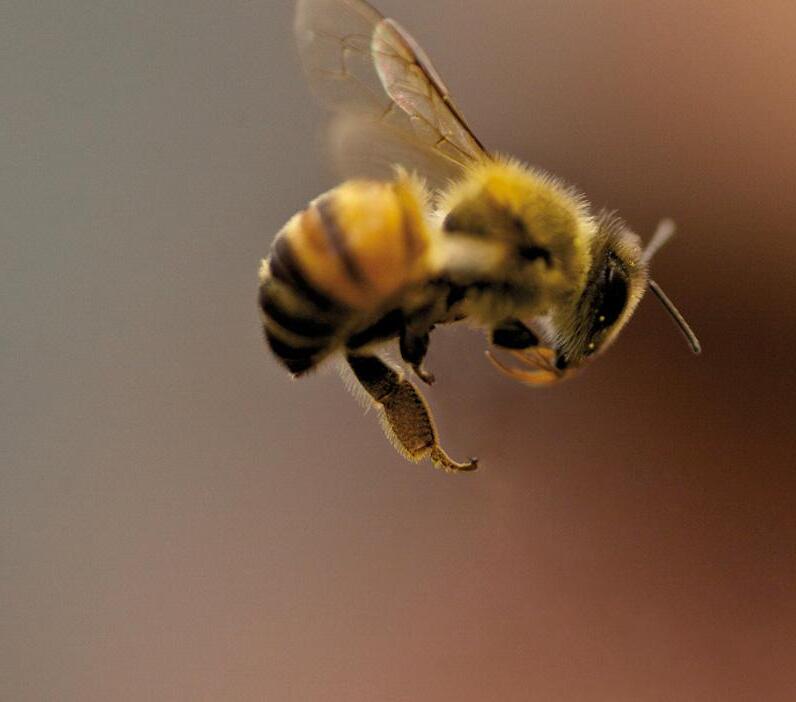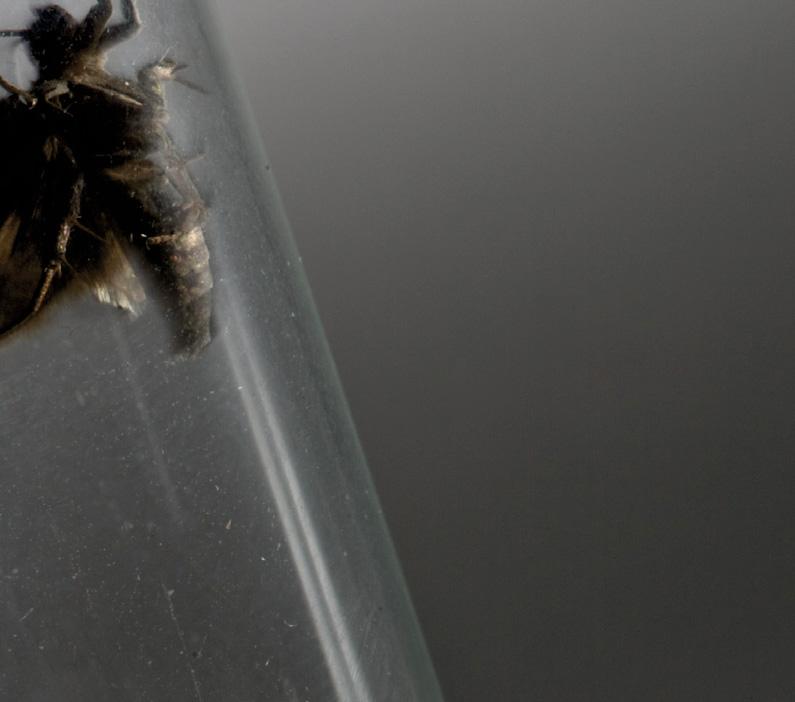
9 minute read
Lorem ipsum legimus nostrum elaboraret ne nec, error omnes pericula ad usu.
Interactions in living systems
Understanding interconnectivity to improve pest and disease control in a changing world
Even where they are highly modified by human activities, such as agriculture, ecosystems are comprised in a dense network of signals used by the species that inhabit them. Various forms of communication between individuals of the same or different species of plants or animals are linked by diverse trophic relationships.
For example, many plants have evolved defences against certain pathogens and pests including the emission of toxic or repellent substances, yet at the same time they release volatile metabolic compounds into the environment that attract other enemies as well as useful predatory or parasitic organisms and pollinators. In the phyllosphere and rhizosphere, complex mechanisms guarantee the equilibrium among microorganisms.
On the other hand, insects use specific olfactory or mechanical stimuli (pheromones, vibrations) to guide them to a potential mate, while in more complex societies, such as those of bees, neurophysiological mechanisms and forms of communication are strikingly similar to those of higher animals. The more specific and complex these relationships, the more they are susceptible to human disturbance. However, even effective management can have unintended negative effects causing the decline in insect pollinators or introducing new plant disease epidemics.
The province of Trentino and FEM have been pioneers in studying the means of communication used by species of interest to agriculture and are currently at the forefront internationally in implementing control strategies that work by interfering with these codes, such as mating disruption in vine moths.
Continuous studies, some aspects of which we present here, are essential in order to improve the methods already in place and adapt them to current global change, and above all in order to implement innovative measures against numerous emerging diseases. A further objective is to understand how external factors affect the delicate neurobiological balance of the species being studied. A consequence of this is that the information gathered will enable us to act more quickly against the invasive organisms that are regularly being introduced to our environment as a result of changing environmental conditions and the globalisation of trade and commerce, necessitating an ever greater vigilance.
The ultimate goal is to add to our knowledge on the interactions between species and environments to in-depth knowledge of plant biology based on the genomes that are being acquired by FEM, in order to arrive at economically and ecologically sustainable management of agroecosystems.
4. 1
Investigating the memory of bees
Bee species are the most environmentally important insects on Earth, providing an essential contribution to pollination in about 80% of crops. A serious decrease in the bee population could cause a massive reduction in crop production with consequent damage to the agricultural economy. Bee populations are dramatically declining all over the world and scientists have not yet found a definitive cause, which may be due to several factors.
Most of the possible causes seem to be directly associated with the beesʼ olfactory nervous system, impairing their memory and ability to learn.
However, the mechanisms of these interactions are still a matter of conjecture. Understanding the neurophysiological processes involved in the recognition, transduction and processing of olfactory stimuli in different species of bees is, therefore, of fundamental importance and is the goal of our project.
More specifically, we are analysing asymmetries in olfactory perception and learning. Right-left asymmetry in neural structures is associated with cognitive skills and is a common and well-studied phenomenon in vertebrates. Brain asymmetries in insects seem to be correlated with long-term memory. It has recently been revealed that social populations consisting of unequal numbers of left- and right- lateralised individuals may be an evolutional stable strategy where asymmetrical individuals must coordinate their behaviour with other asymmetrical organisms in a given population.
To verify this hypothesis in insects we are carrying out a comparative study of three different species of Apoidea with different social structures: the honeybee Apis mellifera, a perennial eusocial species, the bumblebee Bombus terrestris, an annual social species, and the mason bee Osmia cornuta, a solitary species.
The research is being carried out in collaboration with the Center for Mind/Brain Sciences (CIMeC) and the Department of Physics of the University of Trento. The proj- ectʼs aims are also being pursued by a recently established research unit, the Invertebrate Neurobiology and Neuroecology Laboratory, shared between FEM and CIMeC.
We examined right/left electroantennographic (EAG) recordings to different odourants and memory recall tests to odour conditioning using the proboscis extension reflex (PER) with a single antenna in use. Results showed significantly greater PER recall and EAG responsiveness in the right than in the left antenna at the population level in honeybee but not in the non-social mason bee.
Bumblebee showed populationlevel right asymmetry in PER learning tasks, but both number and EAG responsiveness of the olfactory receptors were only slightly higher on the surface of the right than on the left antenna.
Thisstudy is the first contribution to elucidating the evolution of population-level asymmetries as distinct outcomes of different social selection pressures in insects and it will help in the protection of pollinators.
Scanning
electron microscopy analysis on antennae support peripheral asymmetry in honeybees and reveal a significant morphological difference in the number of olfactory sensilla, these being more abundant on the right than on the left antenna surface.

4. 2
Vibrations could replace insecticides for the control of grapevine leafhoppers
Many insects communicate by means of substrate-borne vibrational signals. When associated with mating behaviour, these signals carry essentially two kinds of information: who and where. Different signal parameters, such as frequency, intensity and rhythm of signal emission, confer high species-specificity through which a male can identify and locate a conspecific female on the same plant. An accurate study of insect communication systems constitutes the key factor in understanding the basic mechanisms that regulate their mating behaviour.
Disruption of the mating communication of a species can dramatically affect their chances of successful reproduction. Although nowadays field applications of mating disruption concern mainly sexual pheromones, applied principally to moth pests as odours, the same principles can be applied to other communication systems. In the case of vibrational signals, the
Communication through substrate vibrations.
Disruption Can Be Applied To Insect Pests By Playing Back

transmission of appropriate masking vibrations onto the substrate (host plant) would be an effective way of interfering with the proper insect mating signals.

The leafhopper Scaphoideus titanus Ball is the vector of the Flavescence dorée phytoplasma, a harmful grapevine disease. Mandatory insecticide treatments are required for the control of this insect, compromising all the benefits obtained from the use of ecocompatible strategies, such as pheromone mating disruption against grapevine moths, which have seen a large reduction in chemical usage over time. The mating behaviour of S. titanus is mediated by vibrational signals.
Another important characteristic is a remarkable male-male rivalry, where one male emits specific masking signals to disrupt its rivalʼs mating communication with a female.
A given male only temporarily interrupts the communication of a pair in order to replace its rival in the vibrational duet with the female as the new suitor.
Taking inspiration from this natural example, we recorded, manipulated and then played back the male rivalry signal into grapevine plants. Electromagnetic shakers were attached to vine-supporting wires to transmit the disruptive signal throughout the grapevine plants.
Pairs of S. titanus were confined on the plants and subjected to the vibratory treatment for 16 hrs. Afterwards, the females were removed and dissected to check the number of eggs in the ovarioles. The method turned out to be highly effective, with almost all of the treated couples still virgin, whereas the majority of the untreated females had been mated.
Further experiments on mating disruption by vibrational signals are in progress. The potential of this technique appears to be considerable, especially as far as instruments and application methods are concerned. The use of a pest control method based exclusively on physical/mechanical principles would open new scenarios for ecocompatible management of crops as an alternative to the large-scale use of chemical insecticides.
4. 3
The role of plant volatiles in insect-plant interactions
We are studying the ecological role of plant volatiles in insect-plant interactions. These trophic relationships are mediated by plant chemistry, and it is well known that secondary plant metabolites, such as plant volatiles, serve as signals for herbivorous insects during host-location and oviposition.
We hypothesised that herbivorous insects, such as the grapevine moth Lobesia botrana, rely on volatile signals from the substrate to assess the quality of food for their offspring. We also predicted that food quality and volatile signal are both affected by the microorganisms interacting with the plant.
To test this, we correlated moth oviposition preference for grapes infected with micro-organisms with the fitness of the larvae on a diet supplemented with different micro-organisms. In fact, female oviposition preference correlated with the nutritional value of the food sources. Attractive oviposition sites, such as yeasts, resulted in an increased level of fitness.
Insects recognise food quality from odours

Instead, a pathogenic fungus (Botrytis cinerea) with a detrimental effect on insect fitness discouraged oviposition. Therefore, we showed that the quality of a host plant as larval food for a herbivorous insect is greatly affected by the presence of pathogenic or saprophytic microorganisms on the plant.
Thevolatile bouquet released by the plant-microbe(s) association signals the quality of the food source to egg-laying females. The preference-performance hypothesis, according to which ovipositing females evolved to lay eggs on hosts on which their offspring perform best, was confirmed in L. botrana
There are still gaps in our knowledge about how different sensory modalities (taste and vision, and their interaction with each other and with olfaction) and addi- tional plant-microbe associations interact in shaping plant-microbeinsect associations.

In the context of the preferenceperformance hypothesis, there is still no clear distinction between preference for oviposition site on which the offspring will perform best and attraction to sites that enhance the fitness of the egg-laying adults.
Investigation of the information carried by volatile signals from oviposition sites may help to decipher the codes (i.e. the volatile blends) sending different behavioural messages to egg-laying females.
Knowledge of how behaviourally active volatiles signal to egg-laying females will help us to develop new methods for low-impact management of pest insects.
4. 4
Perception, coding and the interaction of pheromone and plant signals in the codling moth Cydia pomonella

Insects are surrounded by a complex mixture of odours and from this multitude of signals they must discern and respond to only those that are behaviourally relevant. Sex pheromones mediate communication prior to mating and allow males to find conspecific females, while plant volatiles guide females to food sources and larval host plants. Semiochemicals, both social and environmental cues, are efficient and suitable for area-wide insect control and will thus stimulate industrial development in the world-wide plant protection sector facing food security as a future challenge.
Odour reception is primarily mediated by olfactory receptors (ORs), expressed on the surface of the olfactory receptor neurons (ORNs), which innervate specific antennal sensilla. The signals from activated ORNs are first transmitted to the primary integration centre for olfactory information, the antennal lobe (AL), and then to higher brain centres where they are translated into appropriate behaviours. Sophisticated experimental tools are now available to track the transformation of odour signals from ORs to the olfactory centre in the brain. With these techniques, it is now possible to fill some of the most important remaining gaps in our knowledge of insect olfaction and to develop semiochemicals as efficient and safe tools for insect management.

The codling moth, Cydia pomonella, a world-wide pest of pome fruit, has long been a model in the development of behaviourmodifying chemicals for sustainable insect control. As a first step to studying the molecular mechanisms involved, we identified putative OR sequences in the antennae of male and female codling moths by screening the antennal transcriptome. A cDNA library was constructed on the basis of antennal RNA and pyrosequenced using 454 technology.
Putative OR genes were identified by gene sequence analysis using a BLAST database comparison with OR genes identified in other insect species. We are now extending the putative OR genes to their full length using RACE-PCR and are carrying out a tissue-specificity analysis using qPCR. The spatial and temporal expression of ORs on the antenna and their functional role will be investigated using in situ hybridization, and heterologous expression will be used to functionally characterise selected ORs.
In order to answer the question of how olfactory information is integrated in the codling moth brain, we performed an anatomical study of the AL as a prerequisite for ensuing functional studies.
Three-dimensional reconstruction of the AL structure, based on fluorescence microscopy investigations, led to identification of a specific organisation and number of functional units, glomeruli, involved in the coding of odour quality. The map of the AL was then integrated with electrophysiological recordings of the response of individual neurons in the ALs of males and females to sex pheromone components and behaviourally active plant volatiles by means of intracellular recordings. Stimulation with single chemicals and 2-component blends of them produced both synergistic and inhibitory interactions in neurons innervating different glomeruli.
Thisinitial morphological and functional characterisation of the codling moth AL reveals an integrated pattern of representations of social and environmental odours, suggesting a high level of interaction between these signals. We are currently focusing on a detailed analysis of blend interaction, which involves both AL coding and behavioural studies.



